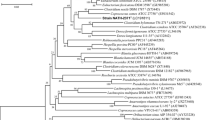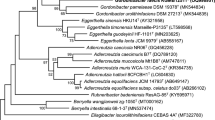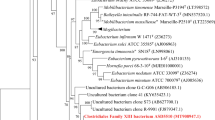Abstract
A bacterial strain that is capable of hydrolyzing plant glucosylceramide (GluCer) was newly isolated from dog feces. The novel strain, designated as strain HFTH-1T, hydrolyzed plant GluCer with a variety of chemical structures, but did not hydrolyze glucosylsphingosine, lactosylceramide, or monosialoganglioside GM3, indicating that strain HFTH-1T produces GluCer-specific glucosylceramidase. Strain HFTH-1T was Gram-positive, anaerobic, oval-spore-forming, rod-shaped, lecithinase-negative, and lipase-negative. It fermented a wide variety of carbohydrates and produced mainly acetate, formate, and lactate from glucose. The G + C content of its DNA was 40.7 mol%. The phylogenetic analysis of 16S rRNA sequence revealed that strain HFTH-1T is placed in the clostridial rRNA cluster XIVa, with Ruminococcus obeum as the nearest relative. Pairwise comparison revealed approximately 5.0% sequence divergence between strain HFTH-1T and the type strain of R. obeum. On the basis of its phenotypic characteristics and phylogenetic divergence, it is proposed that the hitherto unknown rod-shaped bacterial strain HFTH-1T (= DSM 22028T = NBRC 104932T) should be placed in the genus Blautia as a novel species, Blautia glucerasei sp. nov, the only currently known isolate of the species.


Similar content being viewed by others
References
Ahn EH, Schroeder JJ (2002) Sphingoid bases and ceramide induce apoptosis in HT-29 and HCT-116 human colon cancer cells. Exp Biol Med (Maywood) 227:345–353
Ballou LR, Laulederkind SJ, Rosloniec EF, Raghow R (1996) Ceramide signalling and the immune response. Biochim Biophys Acta 1301:273–287
Beiss U (1964) On the Paper Chromatographic Separation of Plant Lipids. J Chromatogr 13:104–110
Bergey DH, Krieg NR, Holt JG (1984) Bergey’s manual of systematic bacteriology. Williams & Wilkins, Baltimore
Bernalier A, Willems A, Leclerc M, Rochet V, Collins MD (1996) Ruminococcus hydrogenotrophicus sp. nov., a new H2/CO2-utilizing acetogenic bacterium isolated from human feces. Arch Microbiol 166:176–183
Bohn M, Heinz E, Luthje S (2001) Lipid composition and fluidity of plasma membranes isolated from corn (Zea mays L.) roots. Arch Biochem Biophys 387:35–40
Collins MD et al (1994) The phylogeny of the genus Clostridium: proposal of five new genera and eleven new species combinations. Int J Syst Bacteriol 44:812–826
Dillehay DL, Webb SK, Schmelz EM, Merrill AH Jr (1994) Dietary sphingomyelin inhibits 1, 2-dimethylhydrazine-induced colon cancer in CF1 mice. J Nutr 124:615–620
Felsenstein J (1985) Confidence limits on phylogenies: an approach using the bootstrap. Evolution 39:783–791
Furuya H, Ohkawara S, Nagashima K, Asanuma N, Hino T (2008) Dietary sphingomyelin alleviates experimental inflammatory bowel disease in mice. Int J Vitam Nutr Res 78:41–49
Gerhardt P (1994) Methods for general and molecular bacteriology. American Society for Microbiology, Washington, D.C
Hannun YA (1994) The sphingomyelin cycle and the second messenger function of ceramide. J Biol Chem 269:3125–3128
Hannun YA, Linardic CM (1993) Sphingolipid breakdown products: anti-proliferative and tumor-suppressor lipids. Biochim Biophys Acta 1154:223–236
Hannun YA, Loomis CR, Merrill AH Jr, Bell RM (1986) Sphingosine inhibition of protein kinase C activity and of phorbol dibutyrate binding in vitro and in human platelets. J Biol Chem 261:12604–12609
Hino T, Shimada K, Maruyama T (1994) Substrate Preference in a Strain of Megasphaera elsdenii, a Ruminal Bacterium, and Its Implications in Propionate Production and Growth Competition. Appl Environ Microbiol 60:1827–1831
Imokawa G, Abe A, Jin K, Higaki Y, Kawashima M, Hidano A (1991) Decreased level of ceramides in stratum corneum of atopic dermatitis: an etiologic factor in atopic dry skin? J Invest Dermatol 96:523–526
Ishibashi Y et al (2007) A novel endoglycoceramidase hydrolyzes oligogalactosylceramides to produce galactooligosaccharides and ceramides. J Biol Chem 282:11386–11396
Ito M, Yamagata T (1986) A novel glycosphingolipid-degrading enzyme cleaves the linkage between the oligosaccharide and ceramide of neutral and acidic glycosphingolipids. J Biol Chem 261:14278–14282
Ito M, Yamagata T (1989) Purification and characterization of glycosphingolipid-specific endoglycosidases (endoglycoceramidases) from a mutant strain of Rhodococcus sp. Evidence for three molecular species of endoglycoceramidase with different specificities. J Biol Chem 264:9510–9519
Kamlage B, Gruhl B, Blaut M (1997) Isolation and characterization of two new homoacetogenic hydrogen-utilizing bacteria from the human intestinal tract that are closely related to Clostridium coccoides. Appl Environ Microbiol 63:1732–1738
Kaneuchi C, Benno Y, Mitsuoka T (1976) Clostridium coccoides, a New Species from the Feces of Mice. Int J Syst Bacteriol 26:482–486
Kolesnick R, Golde DW (1994) The sphingomyelin pathway in tumor necrosis factor and interleukin-1 signaling. Cell 77:325–328
Lampe MA et al (1983a) Human stratum corneum lipids: characterization and regional variations. J Lipid Res 24:120–130
Lampe MA, Williams ML, Elias PM (1983b) Human epidermal lipids: characterization and modulations during differentiation. J Lipid Res 24:131–140
Lane DJ (1991) 16S/23S rRNA sequencing. In: Stackebrandt EaG M (ed) Nucleic acid techniques in bacterial systematics. John Wiley and Sons, Chichester, pp 115–175
Lauter CJ, Trams EG (1962) Spectrophotometric determination of sphingosine. J Lipid Res 3:136
Lemonnier LA, Dillehay DL, Vespremi MJ, Abrams J, Brody E, Schmelz EM (2003) Sphingomyelin in the suppression of colon tumors: prevention versus intervention. Arch Biochem Biophys 419:129–138
Liu C, Finegold SM, Song Y, Lawson PA (2008) Reclassification of Clostridium coccoides, Ruminococcus hansenii, Ruminococcus hydrogenotrophicus, Ruminococcus luti, Ruminococcus productus and Ruminococcus schinkii as Blautia coccoides gen. nov., comb. nov., Blautia hansenii comb. nov., Blautia hydrogenotrophica comb. nov., Blautia luti comb. nov., Blautia producta comb. nov., Blautia schinkii comb. nov. and description of Blautia wexlerae sp. nov., isolated from human faeces. Int J Syst Evol Microbiol 58:1896–1902
Macheleidt O, Kaiser HW, Sandhoff K (2002) Deficiency of epidermal protein-bound omega-hydroxyceramides in atopic dermatitis. J Invest Dermatol 119:166–173
Melnik B, Hollmann J, Plewig G (1988) Decreased stratum corneum ceramides in atopic individuals–a pathobiochemical factor in xerosis? Br J Dermatol 119:547–549
Miyazaki K, Hino T, Itabashi H (1992) Effects of extracellular pH on the intracellular pH and membrane potential of cellulolytic ruminal bacteria, Ruminococcus albus, Ruminococcus flavefaciens, and Fibrobacter succinogenes. J Gen Appl Microbiol 38:567–573
Motta S, Monti M, Sesana S, Caputo R, Carelli S, Ghidoni R (1993) Ceramide composition of the psoriatic scale. Biochim Biophys Acta 1182:147–151
Motta S, Sesana S, Ghidoni R, Monti M (1995) Content of the different lipid classes in psoriatic scale. Arch Dermatol Res 287:691–694
Nilsson A (1968) Metabolism of sphingomyelin in the intestinal tract of the rat. Biochim Biophys Acta 164:575–584
Nilsson A (1969) Metabolism of cerebroside in the intestinal tract of the rat. Biochim Biophys Acta 187:113–121
Ogimoto K, Imai S (1981) Atlas of Rumen Microbiology. Japan Scientific Societies Press, Tokyo, Japan
Okazaki T, Bell RM, Hannun YA (1989) Sphingomyelin turnover induced by vitamin D3 in HL-60 cells. Role in cell differentiation. J Biol Chem 264:19076–19080
Saitou N, Nei M (1987) The neighbor-joining method: a new method for reconstructing phylogenetic trees. Mol Biol Evol 4:406–425
Sato R, Tanaka M (1997) Intestinal distribution and intraluminal localization of orally administered Clostridium butyricum in rats. Microbiol Immunol 41:665–671
Schleifer KH, Kandler O (1972) Peptidoglycan types of bacterial cell walls and their taxonomic implications. Bacteriol Rev 36:407–477
Schmelz EM, Crall KJ, Larocque R, Dillehay DL, Merrill AH Jr (1994) Uptake and metabolism of sphingolipids in isolated intestinal loops of mice. J Nutr 124:702–712
Schmelz EM, Dillehay DL, Webb SK, Reiter A, Adams J, Merrill AH Jr (1996) Sphingomyelin consumption suppresses aberrant colonic crypt foci and increases the proportion of adenomas versus adenocarcinomas in CF1 mice treated with 1, 2-dimethylhydrazine: implications for dietary sphingolipids and colon carcinogenesis. Cancer Res 56:4936–4941
Schmelz EM, Sullards MC, Dillehay DL, Merrill AH Jr (2000) Colonic cell proliferation and aberrant crypt foci formation are inhibited by dairy glycosphingolipids in 1, 2-dimethylhydrazine-treated CF1 mice. J Nutr 130:522–527
Simmering R et al (2002) Ruminococcus luti sp. nov., isolated from a human faecal sample. Syst Appl Microbiol 25:189–193
Spiegel S, Merrill AH Jr (1996) Sphingolipid metabolism and cell growth regulation. FASEB J 10:1388–1397
Sumida T, Sueyoshi N, Ito M (2002) Molecular cloning and characterization of a novel glucocerebrosidase of Paenibacillus sp. TS12. J Biochem 132:237–243
Takahashi Y, Iwai Y, Tomoda H, Nimura N, Kinoshita T, Omura S (1989) Optical resolution of 2, 6-diaminopimelic acid stereoisomers by high performance liquid chromatography for the chemotaxonomy of actinomycete strains. J Gen Appl Microbiol 35:27–32
Tamura K, Dudley J, Nei M, Kumar S (2007) MEGA4: Molecular Evolutionary Genetics Analysis (MEGA) software version 4.0. Mol Biol Evol 24:1596–1599
Thompson JD, Gibson TJ, Plewniak F, Jeanmougin F, Higgins DG (1997) The CLUSTAL_X windows interface: flexible strategies for multiple sequence alignment aided by quality analysis tools. Nucleic Acids Res 25:4876–4882
Tokura Y, Wakita H, Yagi H, Nishimura K, Furukawa F, Takigawa M (1996) Th2 suppressor cells are more susceptible to sphingosine than Th1 cells in murine contact photosensitivity. J Invest Dermatol 107:34–40
Vesper H, Schmelz EM, Nikolova-Karakashian MN, Dillehay DL, Lynch DV, Merrill AH Jr (1999) Sphingolipids in food and the emerging importance of sphingolipids to nutrition. J Nutr 129:1239–1250
Acknowledgments
This study was supported in part by a Grant-in-Aid for Scientific Research (No. 18780205 and 18580274) from the Ministry of Education, Culture, Sports, Science, and Technology of Japan (MEXT), and by “High-Tech Research Center” Project for Private Universities: matching fund subsidy from MEXT, 2006–2008. We express our thanks to Tsuji Oil Mill co., Ltd. (Matsuzaka, Mie, Japan) for providing purified GluCer.
Author information
Authors and Affiliations
Corresponding author
Additional information
Communicated by Erko Stackebrandt.
Electronic supplementary material
Below is the link to the electronic supplementary material.
Rights and permissions
About this article
Cite this article
Furuya, H., Ide, Y., Hamamoto, M. et al. Isolation of a novel bacterium, Blautia glucerasei sp. nov., hydrolyzing plant glucosylceramide to ceramide. Arch Microbiol 192, 365–372 (2010). https://doi.org/10.1007/s00203-010-0566-8
Received:
Revised:
Accepted:
Published:
Issue Date:
DOI: https://doi.org/10.1007/s00203-010-0566-8




